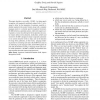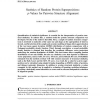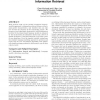1826 search results - page 18 / 366 » Using Random Forests in the Structured Language Model |
AAMAS
2002
Springer
13 years 8 months ago
2002
Springer
Abstract. How and where are the universal features of language specified? We consider language users as situated agents acting as conduits for the cultural transmission of language...
CVPR
2008
IEEE
14 years 10 months ago
2008
IEEE
We present a random field based model for stereo vision with explicit occlusion labeling in a probabilistic framework. The model employs non-parametric cost functions that can be ...
INTERSPEECH
2010
13 years 3 months ago
2010
This paper describes a new toolkit - SCARF - for doing speech recognition with segmental conditional random fields. It is designed to allow for the integration of numerous, possib...
JCB
2008
13 years 8 months ago
2008
Quantification of statistical significance is essential for the interpretation of protein structural similarity. To address this, a random model for protein structure comparison w...
SIGIR
2004
ACM
14 years 2 months ago
2004
ACM
Most previous work on the recently developed languagemodeling approach to information retrieval focuses on document-specific characteristics, and therefore does not take into acc...



